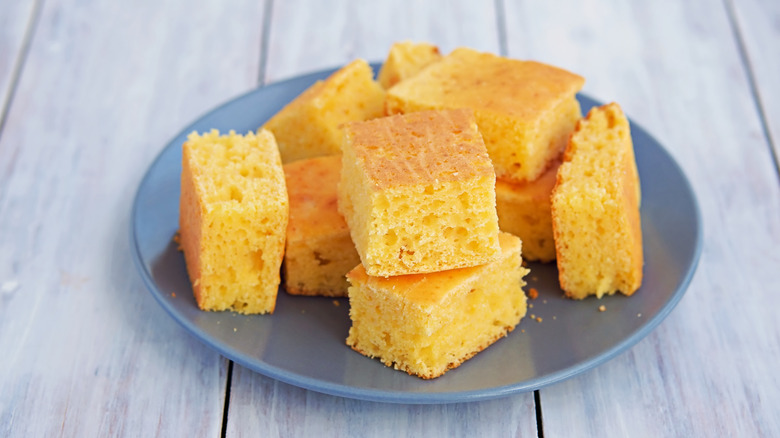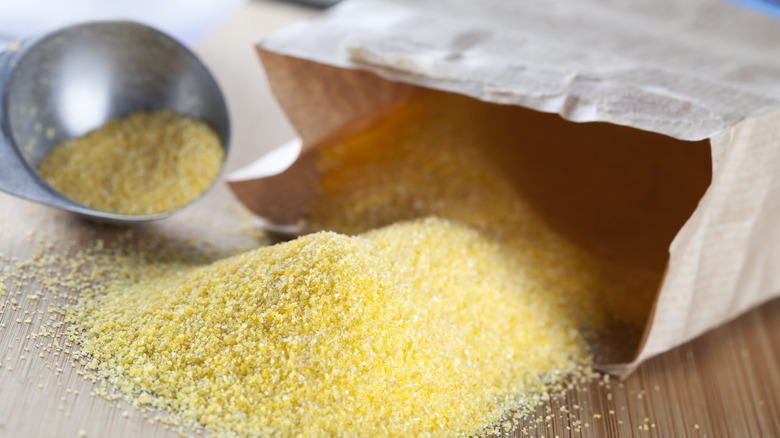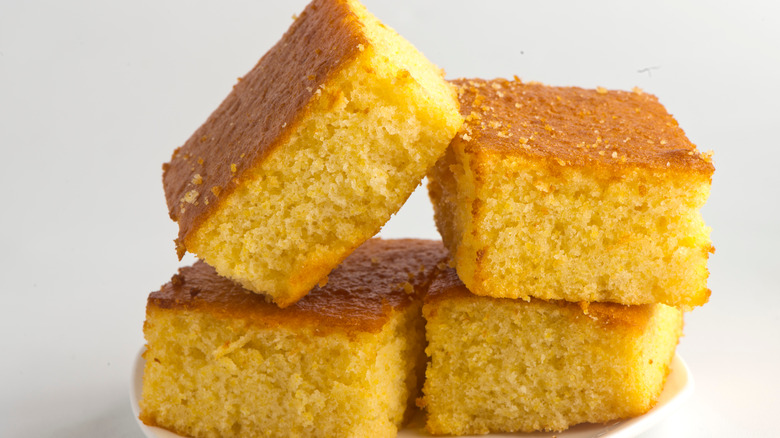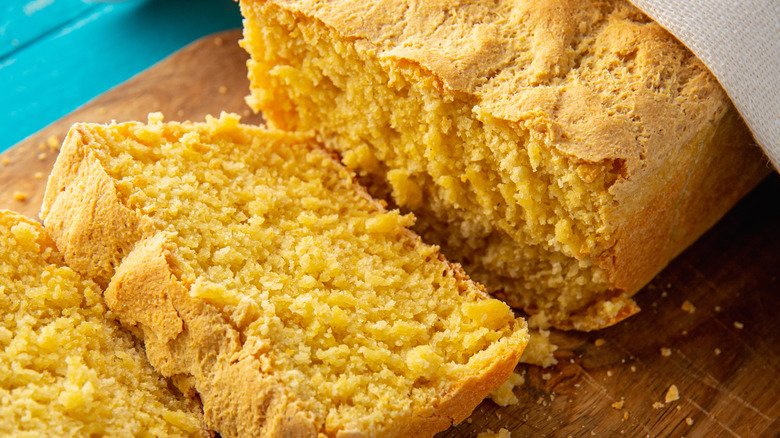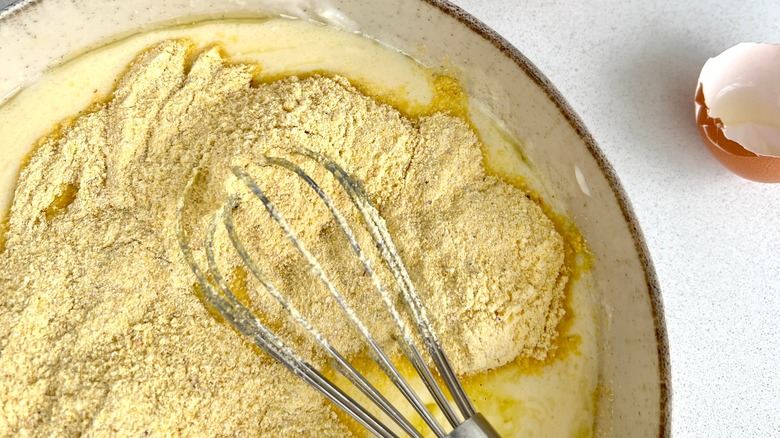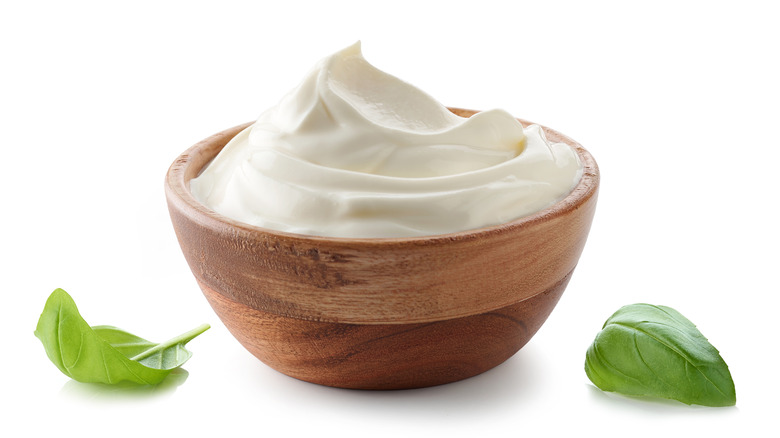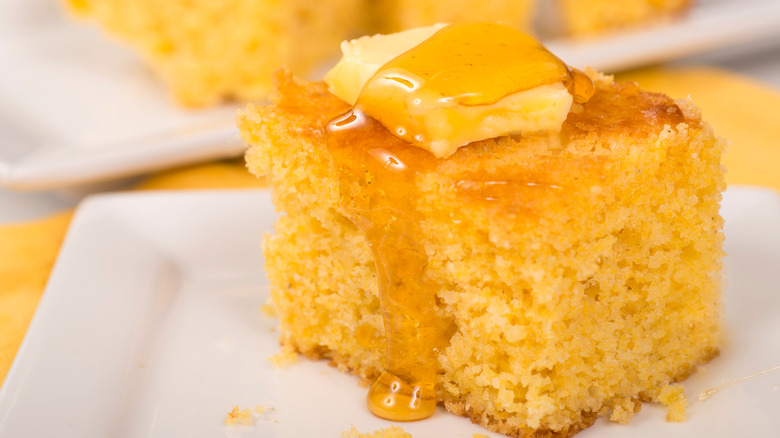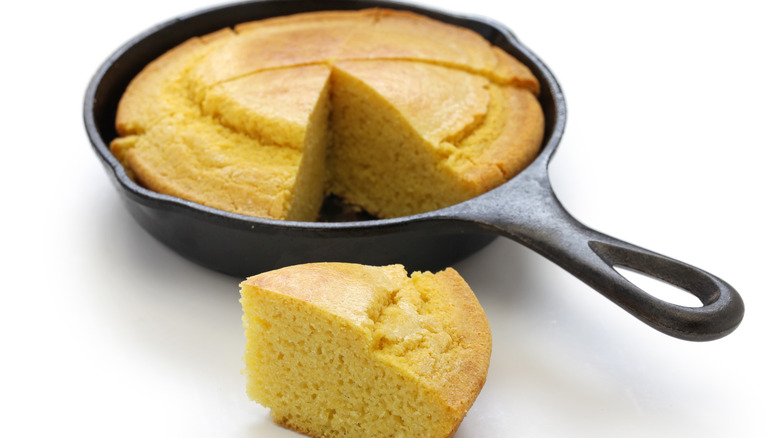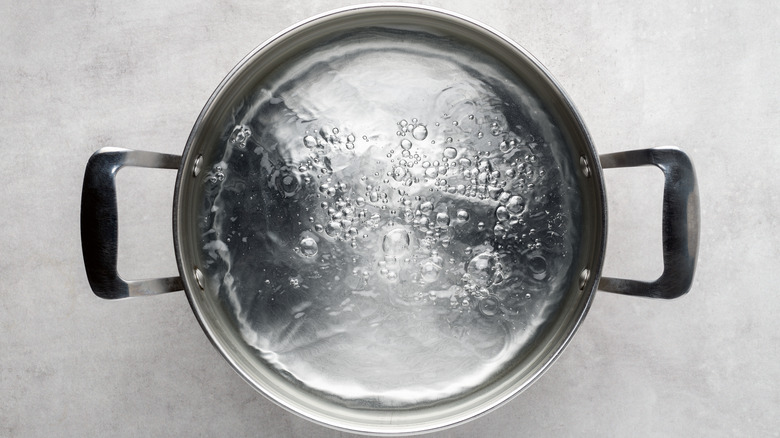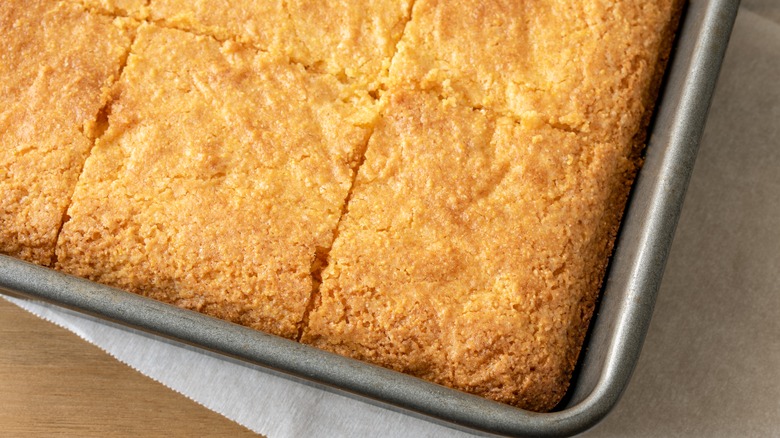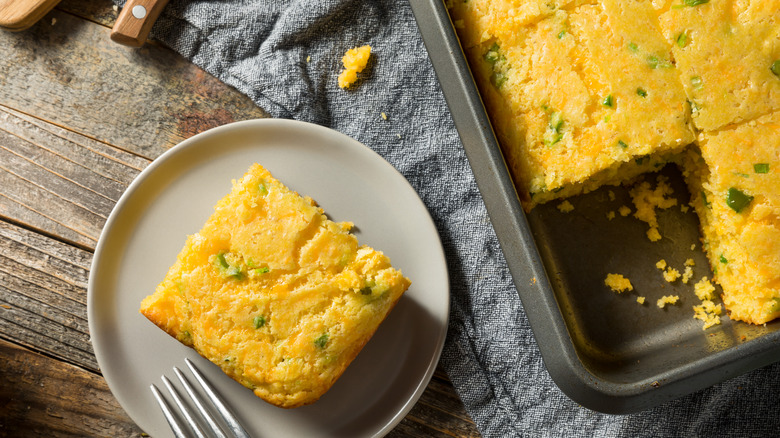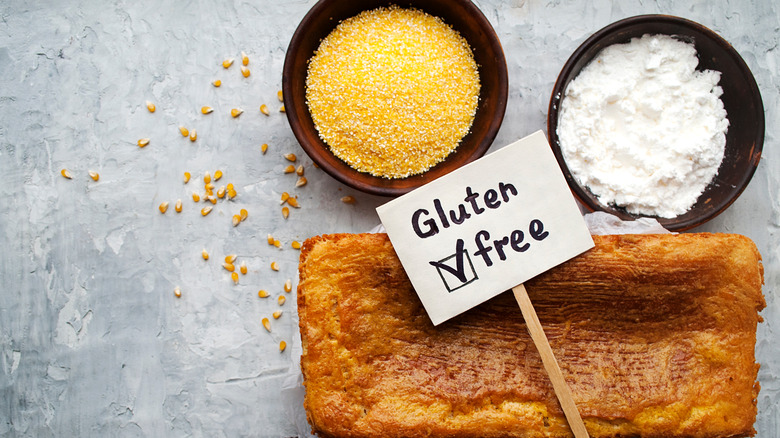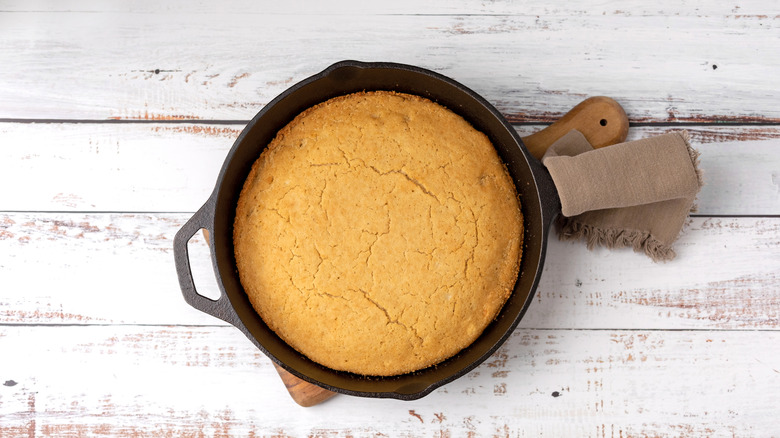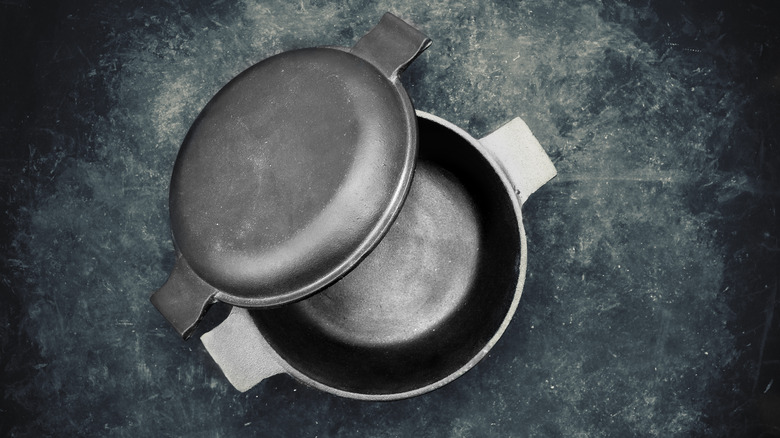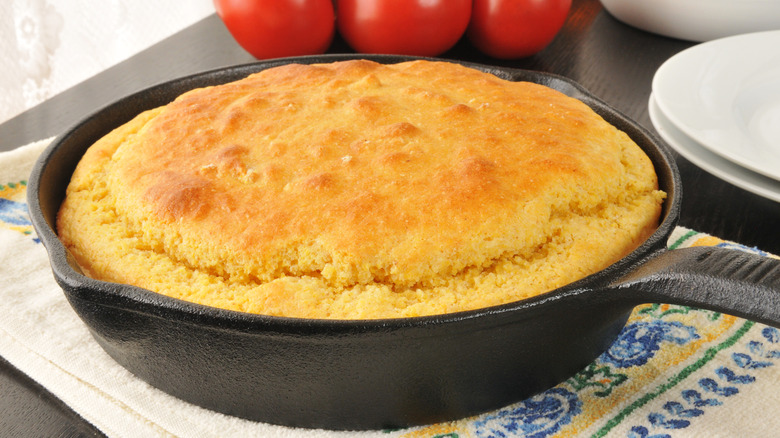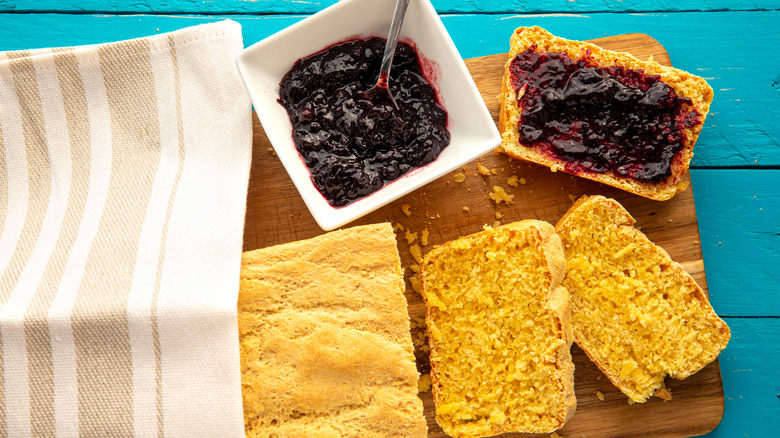15 Tips You Need For The Absolute Best Cornbread
There are just some foods that scream quintessential Southern cuisine: chicken and waffles, fried chicken, and of course, cornbread. According to The Stanford Daily, cornbread's history parallels many other foods we view as "American cuisine." The indigenous people were the first groups to cultivate corn, and in areas where wheat could not be grown, such as the American South, corn quickly took off as an essential crop. The colonists began combining cornmeal and water over a hearth — the first iterations included beans or rendered fat for flavor. Eventually, the hearth was phased out as a cooking method, and baking the meal in a skillet coated in bacon grease or fat drippings were used instead.
Cornbread is relatively easy to make at home, especially with the proliferation of pre-made cornbread mix. But there's just something about the moist, flavorful cornbread you get at Southern diners that may make you want to make the entire recipe on your own. Here are some of our best tips for creating flavorful, moist, and delicious cornbread at home.
Use coarse-ground cornmeal for more nuttiness
The base of cornbread is cornmeal; it provides the bread with a grainy texture. Most grocery stores exclusively sell a standard medium-coarse grind yellow cornmeal. But, if you consult online retailers or bulk grocery stores, you may find a greater variety of cornmeal sizes that will influence the flavor and consistency of the cornbread.
If you like cornbread with more flavor and nuttiness, you can make a simple upgrade to your cornbread by adding more coarse cornmeal than the finer varieties most commonly used in cornbread recipes. Stone ground cornmeal contains the corn's germ and hull, meaning you'll get a flavor comparable to that of whole-grain bread. It is important to remember when using stone-ground cornmeal that the meal will not have the same shelf life as a powdered cornbread mix, so you should always store the mix in your refrigerator or freezer to slow it from becoming rancid.
Choose the color of cornmeal based on the texture you desire
Similar to how cornmeal can come in many different sizes, it can also come in many different colors, including pale blues and pinks — but the most common colors are yellow and white cornmeal. Northern cornbread almost exclusively uses yellow cornmeal, but you can find Southern cornmeal products containing white or yellow cornmeal. One of the biggest mistakes people make with cornbread is always using the yellow variety. Southern cornbread is made with plain white cornmeal or self-rising white cornmeal, and self-rising cornmeal contains baking powder and salt. Silver Bow Bakery notes that if a recipe requires one cup of self-rising cornmeal, you can substitute one cup of cornmeal, 1½ teaspoon baking powder, and ½ teaspoon salt.
Why would you use white cornmeal over yellow cornmeal? White cornmeal is made from the same part of the plant as yellow cornmeal but has a much more subtle flavor. If you like sweet, cake-like cornbread, use yellow cornmeal instead of the white variety.
Add whole corn to diversify your cornbread's texture
Cornbread can come very monotonous very easily. But one way to easily improve the flavor and texture of your cornbread is to go back to its roots — by adding corn, of course!
Southern Living recommends adding whole corn to your cornbread to help improve its texture. You can use canned, rinsed corn, or pull out a bag of corn from your freezer and add it directly to the mix — no thawing required. The website recommends starting with half a cup of corn, but you can always add more if you'd like to add a more profound corn flavor. If the whole pieces of corn aren't your forte, you can instead consider chopping the corn into smaller pieces. If you have a food processor handy, consider blitzing your corn until it resembles a smooth puree. This textural addition will instantly upgrade your cornbread.
Utilize white flour to increase the protein content of the bread
While cornmeal is a vital flavoring and texture agent in cornbread, you should be taking a more precise look at the wheat flour in your recipe. Delishably notes that flour is an important binder in cornbread. If you use too much cornmeal and not enough flour, your cornbread won't have the gluten structure and protein to stay together without crumbling. The website also recommends using Gold Medal Flour, but we couldn't find any reason why your generic grocery store brand won't work just as well.
Our recipe for buttermilk cornbread uses equal parts white flour and yellow cornmeal. Some recipes will use a scant amount of bread flour because it has a higher protein and will keep the bread spongy and soft. But the flour isn't the only ingredient that helps keep the cornbread together — the buttermilk in the recipe is important to keeping the cornbread plush, soft, and moist.
Add a scoop of sour cream to keep the cornbread moist
Sour cream is a miracle ingredient in cooking and baking. If you add sour cream to your cornbread, you'll find the texture of the bread holds together much better and is plusher than if you omitted the sour cream. Since sour cream contains lactic acid bacteria, the acid softens the bread and provides a unique tang that will make your cornbread especially memorable.
If you are worried about making cornbread too tart by adding the sour cream, you can add a little bit of vanilla to help offset some of the tang. If you love the savory flavor, you can substitute more of the milk in the recipe for sour cream. Granted, adding a more viscous dairy product to your cornbread will alter the texture of the batter. If you need to, thin the batter out with more water, so it has the runny consistency of pancake batter.
Pay attention to your fats to prevent crumbling
Fat serves an important function in cornbread, so you shouldn't neglect to add it to your cornbread recipe. Our Everyday Life notes that adding fat to cornbread doesn't necessarily increase its moisture content, but it does make the consistency of the crumb much softer. When you bite into the cornbread, you'll find that it won't crumble into pieces and leave a trail all over your plate.
Fat isn't uniform in all cornbread recipes. You can use egg yolks, melted butter, or shortening in your recipe. Another, albeit unconventional, ingredient you can add to cornbread is mayonnaise. Mayonnaise serves the same function in a cake as in cornbread; the combination of the oil, egg yolks, and vinegar helps soften the crumb and keeps the bread soft. While you should add a bit of butter to your cornbread before baking, you should also try adding a pad of butter and honey to the top of your cornbread after pulling it out of the oven.
Let your cornmeal soak to increase hydration
The best thing you can do with cornbread is to take your time, even if it's counterintuitive to the "Jiffy" namesake. But taking a little bit of time to soak your cornmeal before adding it to the batter is the secret to soft, plush cornbread. The San Diego Union-Tribune recommends letting your cornbread batter sit for at least ten minutes after mixing it before adding it to the skillet. If you use flour, this will allow the gluten to relax, thus keeping the cornbread tender. You can also mix the cornmeal and the buttermilk the night before you plan to make the cornbread; this step makes the grain more tender and less gritty after you try to bake it. If you plan to use a thicker dairy product in your cornbread recipes, such as sour cream or yogurt, you should mix the respective product with the cornmeal a few hours ahead of time.
Try hot water cornbread
If you like to work with old-fashioned recipes, you'll love our recipe for hot water cornbread. Unlike the traditional cornbread recipe, which involves mixing the batter and adding the batter to a greased skillet, this dough is shaped into small patties and cooked on a skillet. Another key difference is that the hot water cornbread uses hot water to help keep the cornbread soft. Hot water cooks the cornmeal, so you won't have to fry it in the oil for as long.
Making hot water cornbread couldn't be any easier. You can heat your hot water in an electric kettle before stirring it into the cornmeal with sugar and salt. The dough is harder than a batter-like consistency, which means that the dough will hold up better once it's shaped and fried. You can serve your cornbread patties with your other dinner favorites, including chili, chicken, or even for breakfast.
Consider adding sugar
The idea of adding sugar to cornbread is surely a contentious one. Traditional, Deep South cornbread recipes won't touch sugar-sweetened cornbread with a ten-foot pole. Since the indigenous communities only used cornmeal and water to make their cornbread, many cornbread recipes found outside of New England stick to tradition. But New England cornbread recipes bring on the sugar — in everything, including granulated sugar, molasses, honey, and even maple syrup. Northern cornbread recipes also usually contain a higher ratio of white flour to cornmeal.
Should you add sugar to your cornbread? That question is just a matter of personal choice. Your cornbread isn't considered any less cornbread if you seek a bit of sweetness — it can be especially helpful if you plan to use your cornbread as a breakfast food or make it into cornbread muffins. If you plan to add cheese or bacon to your cornbread, you might want to stick with the simple, unsweetened cornbread version.
Play with spices for optimal flavor
Cornbread should never be bland, sad, and unflavorful. There are numerous spices you can use to boost the flavor of your cornbread, depending on what kind of flavors you want to impart to your creation. SPICEography notes that one of the most popular flavors to add is jalapeños. You can purchase fresh jalapeños or purchase the canned variety and add them to your cornbread at the end of mixing. Pair chopped jalapeños with cheddar cheese and chopped pieces of bacon for an optimal savory flavor.
You can also add a bright aromatic punch from fresh or dried basil. If you don't want to add chopped basil directly to the batter, you can use herb butter to impart flavor, but just on the grassy organic notes of the basil leaves. If you like the underlying heat of homemade garlic, you can add freshly chopped garlic to the batter or schmear garlic butter on your slice of cornbread after it's finished baking.
Try to make gluten-free cornbread
If you have a gluten allergy or intolerance, you shouldn't have to miss out on a good piece of cornbread. You can make gluten-free cornbread at home by using gluten-free flour to replace all-purpose flour. You can substitute dairy products with non-dairy products like almond milk to create a versatile dish for folks with other allergies.
Our favorite gluten-free flour is unequivocally the King Arthur Baking Company All-Purpose Gluten-Free Flour. It's made with a mix of white rice flour, brown rice flour, and starches to give it the same consistency and texture as all-purpose wheat flour. While there are more unconventional gluten-free flour types that you can use in cornbread, you'll want to select an all-purpose flour to absorb upsetting the precarious balance of flavor and texture in your dreamy cornbread. Almond flour and oat flour, for example, are too fibrous for cornbread compared to rice flour.
Only use a cast iron pan
Cast iron skillets and cornbread are a match made in heaven. Because the skillet is made with iron, it retains heat better than other types of pans. The even distribution of heat from a cast iron skillet means that your cornbread will be equally as crunchy on all sides.
Cornbread is one of the best uses for your cast iron skillet, but you will first need to ensure your cast iron pan is well seasoned before you even think about adding batter. You can buy cast iron pans that are already pre-seasoned, but you will need to regularly re-season your skillet to ensure that your cornbread doesn't stick to your skillet when you go to slice it. Highly acidic foods tend to break down the oil layer on the pan, so you should be prepared to re-season the pan if you frequently prepare food with citrus or vinegar. And re-seasoning doesn't have to be complicated; just add a thin layer of oil to the pan and bake it in the oven at around 450 F for an hour (via Lodge).
Preheat your cast iron skillet to prevent sticking
Committing to a cast iron skillet is only part of the battle. You should always preheat your skillet before you bake your cornbread to prevent the batter from sticking and causing immense headaches when you go to slice it. When you preheat your skillet in the oven, the cast iron expands and opens up small abrasions on the surface of the pan. If you cool the pan, it will cause those small abrasions to close and seal. Plus, when the batter is placed into a hot pan, it cooks quicker and develops a better crumb structure that holds up better than if you neglected to preheat the skillet.
When you are ready to add your batter to the pan, swish a pad of butter around in the pan to develop another protective layer for your cornbread — not to mention a more profound buttery flavor. If you want to preheat your skillet, you can alternatively heat it on a medium-high stovetop (via Lodge Cast Iron). But, since you have to preheat your oven, you can just feed two birds with one scone — or a piece of cornbread.
Let your cornbread cool before slicing
If you've spent all this time perfecting your cornbread recipe, you might be inclined to pull it out of the oven and slice it right away. But you should resist slicing your cornbread until the bread has cooled for between 10 and 15 minutes.
Allowing your cornbread to sit for a while will allow the bread to finish baking in the residual heat of the cast iron pan. According to Leftovers Then Breakfast, the center of the cornbread is usually the last to cook, so waiting to cut into your bread will optimize its crunchiness and prevent your bread from crumbling when you cut it. To improve your ease of slicing, Leftovers Then Breakfast recommends quickly running a knife around the edge of the cornbread to remove any residual pieces that may have not yet receded from the side of the pan as the bread was cooking.
Pair the cornbread with fruit
If you're a cornbread purist, the thought of adding additional sugar to your cornbread might seem appalling. But there are other options to keep your cornbread sweet without resorting to sugar. We love pairing the graininess of yellow cornbread with a schmear of jam or preserves. Or, you can serve your cornbread alongside macerated peaches for a summery dish.
If you want to add fruit to your cornbread, you should be aware of how the moisture from your fruit impacts the hydration of the batter. You can add frozen blueberries to your cornbread, but you should be wary to always coat your berries in flour before adding them to the batter; this prevents the juice from leaking into the batter and coloring it. You can also pair fruits with a burst of acid, such as lemon juice or zest, to help curb some of the sweetness and balance out some of the flavors more.
